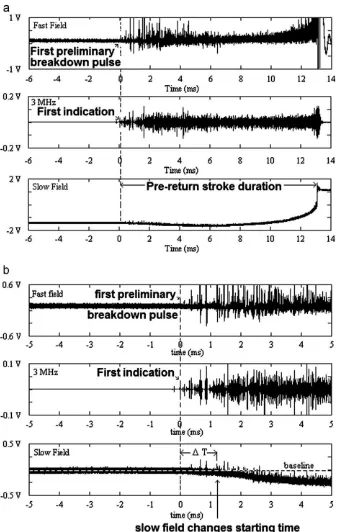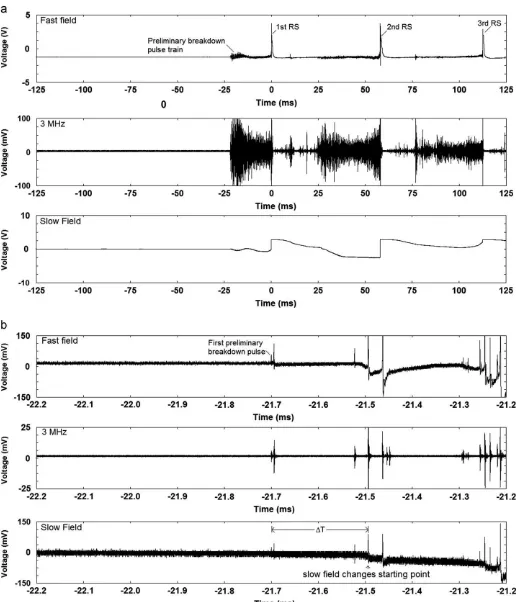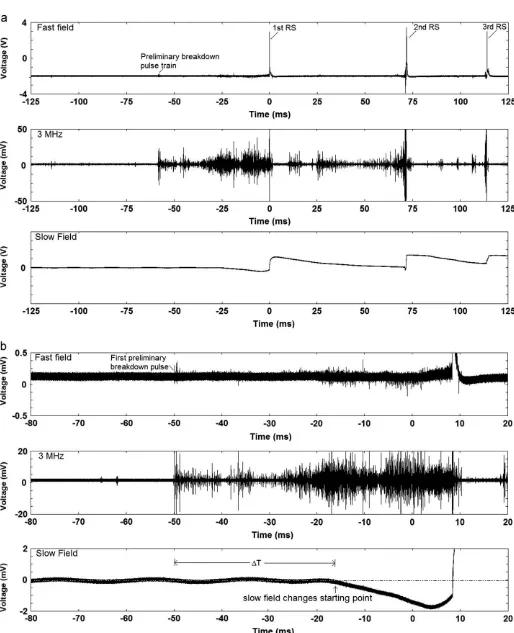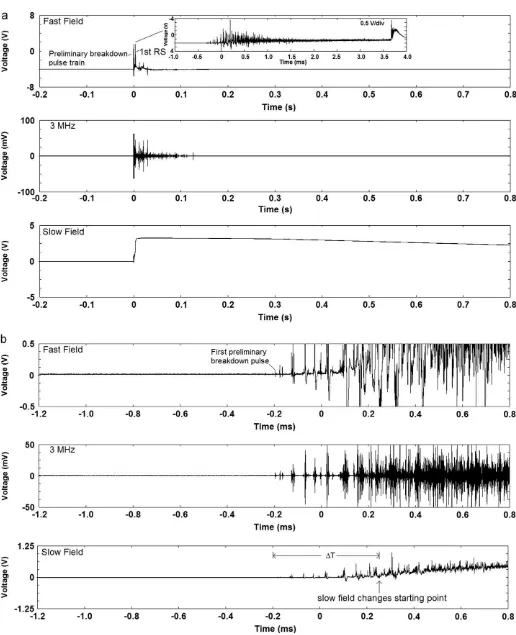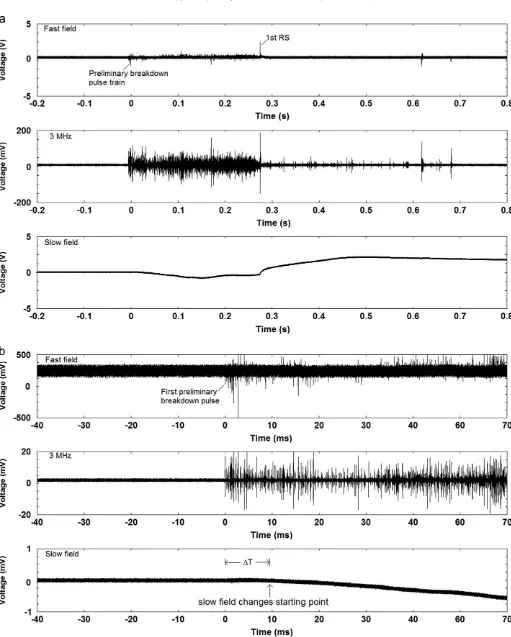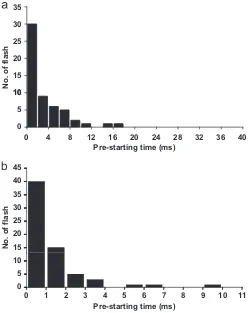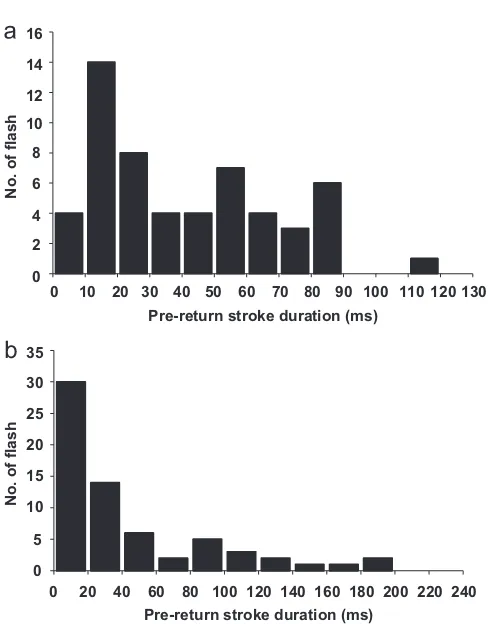and sharing with colleagues.
Other uses, including reproduction and distribution, or selling or
licensing copies, or posting to personal, institutional or third party
websites are prohibited.
In most cases authors are permitted to post their version of the
article (e.g. in Word or Tex form) to their personal website or
institutional repository. Authors requiring further information
regarding Elsevier’s archiving and manuscript policies are
encouraged to visit:
Electric field changes generated by the preliminary breakdown for the
negative cloud-to-ground lightning flashes in Malaysia and Sweden
Z.A. Baharudin
a,n, M. Fernando
b, Noor Azlinda Ahmad
a, J.S. M ¨akel ¨a
c, Mahbubur Rahman
a,
Vernon Cooray
aa
Division of Electricity and Lightning Research, ˚Angstr¨om Laboratory, ˚Angstr¨omlaboratoriet, L¨agerhyddsv¨agen 1 Box 534, 75121 Uppsala, Sweden
b
Department of Physics, University of Colombo, Sri Lanka
c Available online 11 May 2012
Keywords:
We present the study of the electric field changes generated by the preliminary breakdown for negative cloud-to-ground lightning flashes in Malaysia and Sweden concerning the association of slow field changes associated in preliminary breakdown process. We examined the total of 1685 negative cloud-to-ground lightning flashes from the total of 39 thunderstorms by recording the slow electric field, fast electric field and narrowband radiation field at 3 and 30 MHz signals simultaneously. Our results show that there is a pre-starting time, i.e. the duration between the first preliminary breakdown pulse and slow field changes starting point, which is found to be after the first preliminary breakdown pulse. The pre-starting time has the arithmetic and geometric mean range from 1.4–6.47 and 1–3.36 ms, respectively. The mean values of pre-starting time in Malaysia are greater than the values observed in Sweden by more than a factor of 3. From the two data sets it shows that the slow field changes never start before the preliminary breakdown. Furthermore, the use of single-station electric fields measurement with high resolutions of 12 bits transient recorder with several nanosecond accuracy allow one to distinguish the slow field changes generated by preliminary breakdown, which preceded the negative first return stroke, between tens to hundreds of milliseconds of pre-return stroke duration.
&2012 Elsevier Ltd. All rights reserved.
1. Introduction
All lightning processes are associated with the motion of charge and, therefore, can be studied via the measurement of electrostatic field (slow field changes), radiation field (fast field changes) and magnetic fields associated with the charge motion. The electromagnetic field measurements show that, probably 90% of all negative cloud-to-ground flashes that are initiated in the cloud, initially develop in an overall downward direction, and transport negative charges to the ground. The electric field changes preceding first return stroke in the negative cloud-to-ground flashes have been recorded and characterised by many researchers (Clarence and Malan (1957), Kitagawa and Brook (1960),Takeuti et al. (1960),Harris and Salman (1972),Krehbiel et al. (1979),Thomson (1980),Beasley et al. (1982),Proctor et al. (1988)).Clarence and Malan (1957) were the first researchers presenting BIL-type terminology to describe the electric field changes preceding first return stroke in cloud-to-ground flashes.
Clarence and Malan (1957) suggested the return strokes usually preceded by three successive discharge processes which are known as the initial breakdown or also refer to preliminary breakdown (B), intermediate (I) and stepped leader (L). According toClarence and Malan (1957), the preliminary breakdown was a result of a vertical discharge between the main negative charge center and the lower positive charge center inside the thunder-cloud, which has a duration of 2–10 ms. The preliminary break-down is followed by the stepped leader either immediately or after an intermediate (I) stage, which may have the duration of up to 400 ms. Furthermore, they speculated the intermediate stage was the charging process of the negative charge from the vertical channel of the preliminary breakdown until the field at the bottom of the channel was sufficient to initiate a stepped leader.
The BIL-type terminology was later supported by Uman (1987)
and, Harris and Salman (1972). However,Clarence and Malan’s (1957) suggestion was not widely accepted since a few studies such as Krehbiel et al. (1979), Thomson (1980), Beasley et al., 1982, andProctor et al. (1988)found that the BIL-type terminol-ogy is not completely standardized in their observations. Never-theless, it was shown recently by M ¨akel ¨a et al. (2008)that the BIL-type terminology from their observation was consistent with Clarence and Malan (1957).
Contents lists available atSciVerse ScienceDirect
journal homepage:www.elsevier.com/locate/jastp
Journal of Atmospheric and Solar-Terrestrial Physics
1364-6826/$ - see front matter&2012 Elsevier Ltd. All rights reserved. http://dx.doi.org/10.1016/j.jastp.2012.04.009
n
Corresponding author. Tel.:þ46 18 471 5849; fax:þ46184715810.
E-mail address:[email protected] (Z.A. Baharudin).
According to the researchers mentioned above, the electric field changes prior to the first return stroke in negative cloud-to-ground flashes start to increase slowly which may continue for several tens to several hundreds of milliseconds. Some studies such asKrehbiel et al. (1979),Proctor et al. (1988)andRhodes and Krehbiel (1989)found; a long duration ( long pre-first-stroke field changes by more than 100 ms) of electric field changes preceded the first return stroke had a horizontal channel during the development of preliminary breakdown process preceding step leader. Those observations may support the works ofKitagawa and Brook (1960)who suggested that the intracloud discharges were not related directly to the initiation of step leader field changes.
Up-to-date statistical data on slow field changes generated by preliminary breakdown or also known as preliminary variations preceding the step leader in cloud-to-ground flashes only appear in Beasley et al. (1982). In general, Beasley et al. (1982) char-acterized the electric field changes preceding negative first return stroke as having preliminary variations and step leader. From their observations, 33 (64%) out of 52 negative ground flashes had the preliminary breakdown associated with slow field changes. Furthermore, based on highly subjective decision processes, they selected only 15 available samples from the total of 52 ground flashes. In addition, they found 8 out of 15 ground flash cases whose preliminary variations start before preliminary breakdown process.Beasley et al. (1982)concluded that they were unable to determine whether there are any significant preliminary varia-tions that may precede first return strokes by tens or hundreds of milliseconds.Proctor et al. (1988)used the imaging of lightning as a source of VHF—UHF radiation in conjunction with the electric field records in their observation of 47 negative ground flashes. They stated that the BIL-type electric field changes precede to first return strokes were associated with the development of stepped leaders which some of these leaders were preceded by cloud discharges (cloud streamer). Furthermore, Proctor et al. (1988) interpreted that preliminary breakdown portion as ‘‘the start of the leader’’. However, from their study, there is no significant statistical data informing the electric field change position occurred during the preliminary breakdown process.
We acknowledge several factors that cause limitation to determine preliminary variations feature in the electric field changes preceding negative first return. Therefore, it is very important to consider the explanation by Beasley et al. (1982) and Cooray (2003) about which factors that pinpoint the first detectable slow field changes associated in the preliminary breakdown is complicated. First, in the earlier work of Schonland et al. (1938), he explained about the effect of time constants of antenna circuits for detecting the slow field changes. He claimed that the slow field changes in the preliminary break-down may not be able to be reproduced by the measuring equipment faithfully if the decay time constant is not long enough to allow much certainty. Second, as reported by Beasley et al. (1982), the onset of the preliminary breakdown may produce only a small slow field changes. Therefore, this feature may cause difficulty to detect the first signature of slow field changes in the background noise. Third, the electric activity inside the mature thundercloud such as intracloud may occur continuously espe-cially when the duration exceeds 100 ms. According toKitagawa and Brook (1960), this cloud activity has no connection to the ground flashes, but it may be contaminated by the slow field changes that associated in the earlier portion of preliminary breakdown process which can lead to an error during the analysis. The above mentioned studies reveal that there is inadequate data to define the beginning position of slow field changes associated in the preliminary breakdown process. Therefore, these have motivated us to present the study of electric field changes
generated by the preliminary breakdown process for negative cloud-to-ground lightning flashes; by examining the total of 1685 negative cloud-to-ground lightning flashes recorded in Malaysia and Sweden. In this paper, we aim to improve the unclear features of the electric field changes preceding negative first return especially focusing on the association of slow field changes in the preliminary breakdown process. In the present study, we have recorded the slow electric field, fast electric field and narrowband radiation field (radiation field at 3 and 30 MHz) signals simulta-neously from the total of 39 thunderstorms in Malaysia and Sweden. All precautions related to the limitation factors as described above have been taken into account in the methodology (Section 2). The relevance of the results related to the slow field changes associated in the preliminary breakdown is discussed in Section 3. We draw the conclusions inSection 4.
2. Data and methodology
In Malaysia, the measurements of electric fields generated by the negative cloud-to-ground flashes were recorded from April to June 2009 during the southwest monsoon period in the Johor state at the southern part of Peninsular Malaysia, in close proximity to the equator (Latitude: 11N, Longitude: 1031E). Our measurement station altitude is 132 m above sea level and approximately 30 km away from the Tebrau Straits. We also conducted these measurements during summer in 2010 and 2011, from May to September, in Uppsala, Sweden. In Uppsala (latitude: 59.8 N; longitude: 17.6 E; altitude: 13 m), the site is located 70 km inland of the Baltic Sea. The measurement set up in Sweden was identical to that used in Malaysia.
We used three parallel flat plate antennas to sense fast electric field, radiation fields at 3 and 30 MHz signals, while a whip antenna was used to sense the slow electric field signal. The antenna systems for the fast and slow electric field electronic buffer circuits used for both measuring sites are identical to the literatures described inCooray and Lundquist (1982),Galvan and Fernando (2000)andCooray (2003). The whip antenna consists of a lower metallic rod, an upper metallic rod (3.3 m) and an insulator. The lower metallic rod is buried about 0.5 m in the ground while the other end is about 1.5 m above the ground level. The upper and lower metallic rods were insulated from each other by using an insulator of 0.05 m thickness which have the capacitance of 58 pF. The physical height, insulator thickness and diameter of parallel flat plate antenna is 1.5, 0.05 and 0.45 m, respectively. All three flat plate antennas were placed side by side with a distance of 1 m from each other. The whip antenna was placed 3 m away from the flat plate antenna system. They were located 8 m from the control room where the record-ing system was set up. The plane of antenna is oriented parallel position to the ground, which to ensure the horizontal electric field effect can be eliminated.
A 60 cm long coaxial cable (RG58) was used to connect the antenna to the electronic buffer circuit for a slow and fast electric fields. The zero-to-peak rise time of the output was less than 30 ns when the step input pulse is applied to the fast electric field antenna system. The decay time constant for the fast and slow electric field circuit is determined by a RC circuit. We tune the decay time constant for the fast and slow electric field circuit to 15 ms and 1 s, respectively. The decay time constant for the fast electric field was found to be sufficient for faithful reproduction of micro-second scale while the value for the slow electric field was long enough to allow certainty in our analysis. The tune circuit at 3 MHz is a combination of passive elements where the inductance (47
m
H) is connected in series with the antenna (58 pF) and 50O
30 MHz was constructed by using an active bandpass topology— consists of LMH6559 (speed buffer) and LMH6609 (voltage feed-back operational amplifier). The bandwidth of a tune circuit is at 3 and 30 MHz are 264 kHz and 2 MHz, respectively.
Signals from all antennas were fed by 10 m length coaxial cables (RG-58) into a 4-channel 12-bit digital transient recorder (Yokogawa SL1000 equipped with DAQ modules 720210) through proper termination (50
O
termination). The sampling rate was set to 20 or 100 MS/s with the total length recorded being either 0.25 or 1 s. The transient recorder was operated either in 125 or 300 ms in pre-trigger mode. The trigger setting of the oscilloscope was set such that for the signals of both polarities could be captured.The close distance of the negative ground flashes with a distance less than 16 km were calculated using the thunder ranging method. In this method, the elapsed time between the arrivals of the electric pulses and acoustic signals is divided by the speed of sound to arrive at the distance of the flash. There is an approximate 1 s delay of a possible error when the first electric pulse is displayed in the scope. The trigger level is set in a range of 500 mV–2 V, to ensure only close flashes could be recorded. Although the thunders for the close flashes were audible for less than 20 km, we only limit our selection to less than 16 km to prevent from an uncertainty in time correspond to an uncertainty in distance.
The characteristic of the fast electric field waveform is crucial since it has good reliability to indicate a clear section of processes preceding the first negative return-stroke. In addition, the slow electric field waveform is compulsory to identify the starting position of electric field changes correctly that precede the first negative return stroke. Furthermore, the use of narrowband system (HF radiation at 3 MHz) feature allows decreasing uncer-tainty especially to detect the first preliminary breakdown pulse. Fig. 1 is a brief description to define main parameter as following:
i) The first preliminary breakdown pulse. ii) Slow field changes starting point. iii) Duration of quiet mode (zero static field). iv) Pre-starting time.
v) Pre-return stroke duration.
We applied the criterion as described in the introduction and methodology by Nag and Rakov (2008) for identification of the first preliminary breakdown pulse. For time scaling purpose, the first detectable preliminary breakdown pulse is labeled as zero position. The first preliminary breakdown pulse is considered as belonging to preliminary breakdown portion if the peak-to-peak amplitude is either equal or exceeding twice of the average noise. Furthermore, we considered the first preliminary breakdown pulse as belonging to the preliminary breakdown portion if the separation from the last pulse in the preliminary breakdown section was by at least 2 ms. The average noise in Malaysia and Sweden (for fast field and slow field waveforms) is almost similar. The average noise level for fast and slow field waveforms is found to be 0.008 and 0.01 V, respectively. The slow field changes starting point is defined when the waveform exceeds its noise level. We introduce pre-starting time that is the time interval between the peak of the first preliminary breakdown pulse and starting position of the slow field changes. In addition, the selections of waveforms are considered to have zero static fields or quiet mode duration which has at least 50 ms duration at the offset level before the first detectable preliminary breakdown pulse. Mostly, we selected the samples that had quiet mode by more than 100 ms durations. It is to ensure that there is no occurring activity either from man made or intracloud prior to the
first preliminary breakdown pulse. In this analysis, we use the terminology of pre-return stroke duration to determine the time interval between the peaks of first preliminary breakdown pulse and first return stroke.
3. Result and discussion
We examined the Malaysian data set from a total of 1832 electric fields which consisted of 1299 negative cloud-to-ground flashes and 533 cloud flashes, obtained from 21 convective thunderstorms. The Swedish data set was examined from a total of 697 electric fields recorded from 18 thunderstorms, contained of 386 negative cloud-to-ground flashes, 76 positive to ground flashes and 238 ground flashes. In this study, only 55 of Malaysian data sets and 66 of Swedish data sets were found to be successive negative cloud-to-ground flashes which satisfied the criteria for the determination of initiation position of electric field changes associated to the preliminary breakdown.
Fig. 2 shows the minimum pre-starting time from negative cloud-to-ground flash recorded in Malaysia (20090515-09:15:10. 238147-UTC), which began with zero static field for the entire duration of 100 ms before the first preliminary breakdown pulse. The pre-starting time was found to be 0.22 ms after the first preliminary breakdown pulse while the starting position of the slow field changes occurred in the preliminary breakdown sec-tion.Fig. 3depicts an event of negative cloud-to-ground flash in Malaysia (recorded in 20090528-06:34:16.639292-UTC) where the maximum of pre-starting time was found to be 32.80 ms after the first preliminary breakdown pulse. This flash appeared to begin as quiet mode for the entire duration of 75 ms before the first preliminary breakdown pulse.
In Sweden, the minimum and maximum of the pre-starting time after the first preliminary breakdown pulses are 0.24 and 9.80 ms, respectively (seeFigs. 4 and 5). Both flashes begin with zero static fields for the entire duration of 200 ms before the first preliminary breakdown pulse while the starting position of the slow field changes occurred in the preliminary breakdown section.
The distribution of the
D
T observed in Malaysia and Sweden is given in Fig. 6. The arithmetic and geometric mean of the pre-starting time obtained in Malaysia are 6.47 and 3.36 ms, respec-tively. The distribution of the pre-starting time for Malaysian data set shows that the majority of sample (54%) lies in a range of 0.22–3.7 ms (see Fig. 6a). On the other hand, the histogram in Fig. 6b indicates that, in Sweden, the majority of sample (61%) lies in a range of 0.24–1.00 ms. In the Swedish data set, the geometric mean of pre-starting time is 1.00 ms while the arithmetic mean is 1.40 ms. The results from both countries are summarized in Table 1. Observe that the mean values (arithmetic and geometric mean) of the pre-starting time in Malaysia are greater than the value observed in Sweden by more than a factor of 3. Note that the duration of the pre-starting time is short at the high latitude region while it has long duration in the tropical region. Overall, all the duration of pre-starting time from the two data sets are found to be consistent after the first preliminary breakdown pulse. Furthermore, our results from the samples of the negative cloud-to-ground flashes in two different geographical regions provide the evident that there is no such a case where the slow field changes start before the preliminary breakdown.We plotted the duration of the pre-starting time versus the distance of flash (seeFig. 7) in order to investigate the relation-ship of pre-starting time with the distance of flash and thunder-storm. The correlation between the pre-starting time and distance of flash in Malaysian and Swedish data sets were found to be
has no correlation with the distance of flash, which suggests that the pre-starting time is not influenced by the ground propagation. Fig. 7a (Malaysian data set) indicates the distribution of the pre-starting time may have some tendency to be dependent on a certain thunderstorm event. The thunderstorm on 15/05/2009 (Fig. 7a) shows in the relationships of the pre-starting time versus the distance of flash an exponential decay curve with a correla-tion of 0.72. It conveys that the pre-starting time decreases as the distance of flash increases. Furthermore, we observed the thun-derstorm on 28/05/2011 was dominantly indicating a large number of higher pre-starting time value compared to other
thunderstorm events. On one hand, the Swedish data set shows each of the thunderstorm event has no consistency of distribution either from storm to storm or each of thunderstorm event. On the other hand, our data set is not effective enough to signify the relationship between the pre-starting time and thunderstorm event. Therefore, one should have a large data set if this relation-ship is needed to be better understood.
In this analysis, we defined a pre-return stroke duration as mention in the methodology section and summarized inTable 1. The distribution of the pre-return stroke duration in Malaysia (Fig. 8a) varies from 8 to 114 ms with the arithmetic and Fig. 1.Brief illustration to determine the pre-starting time (DT)—i.e. the duration between the first preliminary breakdown pulse and slow field changes starting point and
geometric mean of 42 and 33, respectively. In Sweden, the arithmetic mean of pre-return stroke duration is 42 ms while the geometric mean is 22 ms. The minimum and maximum of the pre-return stroke duration observed in Sweden was 1 and 189 ms, respectively (see Fig. 8b). The actual means of the pre-return
stroke duration in Malaysia was reported by Baharudin et al. (2010) whose length of recorded mean were similar to those in Sweden. They found the arithmetic and geometric mean of pre-return stroke duration in Malaysia was 62 and 51 ms, respectively.
Fig. 2. Minimum pre-starting time (DT) from negative cloud-to-ground flash recorded in Malaysia (20090515-09:15:10.238147). (a) Time Frame: 250 ms, (b) Time Frame: 2 ms.
Next, we compared our results with the available results obtained byBeasley et al. (1982)whose data set were recorded in Kennedy Space Center of the United State Nation Aeronautics
only from 15 selective data out of 52 negative ground flashes. They classified their findings about the starting position of slow field changes associated in the preliminary breakdown section
into three categories. First, there were 8 cases where the times for the slow field started to change at least 10 ms earlier than the preliminary breakdown section. Second, they found that 3 cases Fig. 4.Minimum pre-starting time (DT) from negative cloud-to-ground flash recorded in Sweden (20110818 11:19:32.443748). (a) Time Frame: 1 s, (b) Time Frame: 2 ms.
in which the start time for the slow field changes were 100 ms earlier than the preliminary breakdown section. Third, the start time of slow field changes was found to be uncertain for 7 cases,
as mentioned in our introduction section. Therefore, we expected those limitations were not allowing them to make clear conclu-sions regarding the slow field change associated in the preliminary breakdown. On one hand, our results which based on two observa-tions in different locaobserva-tions proves a clear evidence of a similar finding that none of the slow field changes associated in pre-liminary breakdown began before the prepre-liminary breakdown section. Furthermore, we observed the time duration between the first preliminary breakdown pulse and the slow field change starting point is always occurring in the preliminary breakdown section.
Our observations from the two different geographical locations apparently show that, the simultaneous measurement of radia-tion field, electrostatic field and HF—VHF narrowband radiation field by using a single-station electric field allows one to distin-guish the slow field changes associated in preliminary breakdown that preceded the negative first return stroke, between tens to hundreds of milliseconds of the pre-return stroke duration. It is fair to note that the use of high resolution of 12 bits transient recorder with several nanoseconds accuracy (10–50 ns) can eliminate any uncertainty in determining the starting position of the slow field changes. We note that a sufficient setting of a
pre-trigger delay time assigned certainty in recognizing any activity before the first preliminary breakdown.
4. Conclusion
From our study of the electric field changes generated by the preliminary breakdown of negative cloud-to-ground lightning flashes in Malaysia and Sweden shows significant features on slow field changes associated in preliminary breakdown process. The statistical data obtained from Malaysia and Sweden shows that there is a pre-starting time, i.e. the duration between the first preliminary breakdown pulse and slow field changes starting point, which is found to be after the first preliminary breakdown pulse. The pre-starting time has the arithmetic and geometric mean ranges from 1.4–6.47 and 1–3.36 ms, respectively. On the other hand, the mean values of pre-starting time in Malaysia are greater than the values observed in Sweden by more than a factor of 3—implying that the pre-starting time is influenced by the latitude effect. Furthermore, our results from the samples in the two different geographical regions show that there is no such case where the slow field changes start before the preliminary
10
Fig. 6. The distributions of the pre-starting (DT) time observed in Malaysia and Sweden.
Table 1
Summary of the statistical results of pre-starting time (DT) and pre-return stroke.
Location Pre-starting time duration Pre-return stroke duration
Minimum Maximum Arithmetic mean Geometric mean Minimum Maximum Arithmetic mean Geometric mean
Malaysia 0.22 32.80 6.47 3.36 8 114 42 33
Sweden 0.24 9.80 1.4 1 1 189 42 22
Fig. 7.Pre-starting time (DT) versus distance of flash. The correlation between the pre-starting time and the distance of flash in Malaysian (Fig. 7a) and Swedish
(Fig. 7b) data sets were0.16 and0.09, respectively.
breakdown. It is appropriate to suggest that the transporting of the negative charge for ground flashes, primarily begin to move down-ward after the pre-starting time within the duration of hundreds microseconds to tens milliseconds, during the development process of initiation breakdown. It appears that the single-station electric fields measurement with high resolutions of 12 bits transient recorder with several nanoseconds accuracy allows one to distin-guish the slow field changes generated by preliminary breakdown, which preceded the negative first return stroke, between tens to hundreds of milliseconds of the pre-return stroke duration.
Acknowledgments
We would like to thank all staff members of Institute of High Voltage and High Current (IVAT), UTM, Malaysia for letting us use their facilities and for their support as well as cooperation during our measurement campaign. This work was funded by grants from the Swedish Foundation for International Cooperation in
Research and Higher Education (STINT), grant IG2004–2031 and Swedish Research Council, grant 621-2006-4299. Participation of Dr. Mahendra Fernando in this study is partly financed by the International Science Programs (ISP), Uppsala University. I would also like to thank Universiti Teknikal Malaysia Melaka for funding my PhD study.
Appendix A. Supporting information
Supplementary data associated with this article can be found in the online version athttp://dx.doi.org/10.1016/j.jastp.2012.04.009.
References
Beasley, W., Uman, M.A., Rustan, P.L, 1982. Electric fields preceding cloud-to-ground lightning flashes. Journal of Geophysical Research 87 (C7), 4883–4902. Baharudin, Z.A., N. Azlinda Ahmad, Fernando, M., Cooray, V., M ¨akel ¨a, J.S., 2012. Comparative study on preliminary breakdown pulse train observed in Johor, Malaysia and Florida, USA, Atmos. Res. (2012), http://dx.doi.org/10.1016/j. atmosres.2012.01.012.
Clarence, N.D., Malan, D.J., 1957. Preliminary discharge processes in lightning flashes to ground. Quarterly Journal of the Royal Meteorological Society 83, 161–172.
Cooray, V., Lundquist, S., 1982. On the characteristics of some radiation fields from lightning and their possible origin in positive ground flashes. Journal of Geophysical Research 87 (C13), 11203–11214.
Cooray, V., 2003. The lightning flash. Institute of Electrical and Electronic Engineers, England.
Galvan, A., Fernando, M., 2000. Operative characteristics of a parallel-plate antenna to measure vertical electric fields from lightning fields from lightning flashes, Report UURIE 285-00, Uppsala University.
Harris, D.J., Salman, Y.E., 1972. The measurement of lightning characteristics in Northern Nigeria. Journal of Atmospheric and Solar–Terrestrial Physics 34, 775–786.
Kitagawa, N., Brook, M., 1960. A comparison of intracloud and cloud-to-ground lightning discharges. Journal of Geophysical Research 65, 1189–1201. Krehbiel, P.R., Brook, M., McCrory, R., 1979. An analysis of the charge structure
of lightning discharges to the ground. Journal Geophysics Research 84, 2432–2456.
M¨akel ¨a, J.S., Porjo, N., M ¨akel ¨a, A., Tuomi, T., Cooray, V., 2008. Properties of preliminary breakdown processes in Scandinavian lightning. Journal of Atmo-spheric and Solar–Terrestrial Physics 70, 2041–2052.
Nag, A., Rakov, V.A., 2008. Pulse trains that are characteristic of preliminary breakdown in cloud-to-ground lightning but not followed by are not followed by return stroke pulses. J. Geophys. Res. 113, D01102.
Proctor, D.E., Uytenbogaardt, R., Meredith, B.M., 1988. VHF radio pictures of lightning flashes to ground. Journal of Geophysical Research 93, 12,683–12,727.
Rhodes, C., Krehbiel, P.R., 1989. Interferometric observations of a single stroke cloud-to-ground flash. Geophysical Research Letters 16, 1169–1172. Schonland, B.F.J., Hodges, D.B., Collens, H., 1938. Progressive lightning, part 5, a
comparison of photographic and electrical studies of the discharge process. Proceedings Royal Society A166, 56–75.
Takeuti, T., Ishikawa, H., Takagi, M., 1960. On the Cloud Discharge Preceding the First Ground Stroke. Proceedings Research Institute Atmospheric, 7. Nagoya University, Japan 1 – 6.
Thomson, E.M., 1980. Characteristics of Port Moresby ground flashes. Journal of Geophysical Research 85 (C2), 1027–1036.
Uman, M.A., 1987. Lightning. McGraw-Hill, New York. 6
